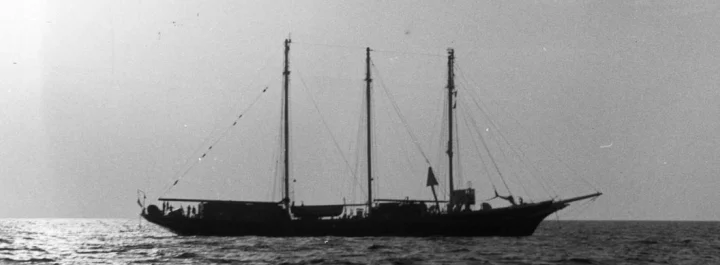New Web Exhibit on the Research Vessel Vema
by Joanna Behrman, Assistant Public Historian at the American Institute of Physics
The Center for History of Physics at the American Institute of Physics has put together a new virtual exhibit which takes visitors on an interactive journey across the world’s oceans aboard the Research Vessel Vema. Formerly a luxury yacht, the R/V Vema became a workhorse of geophysical research during its nearly thirty years of service at Lamont-Doherty Earth Observatory. For instance, the sediment and water samples, heat flow measurements, seismic profiles, paleomagnetic readings and other data collected by scientists aboard the Vema directly contributed to the confirmation of plate tectonics, marrying geological & geophysical research into a unified theory.

Originally named Hussar, the Vema was a three-masted sailing schooner constructed in 1923 for the wife of an American financier. The ship lived several lives – as a leisure vessel breaking records for trans-Atlantic travel, as a Coast Guard patrol boat during World War II, and as a charter vessel before being purchased by Director Maurice “Doc” Ewing of the Lamont Geological Observatory in 1953. From 1953 to 1981, the Lamont Geological Observatory of Columbia University (now Lamont-Doherty Earth Observatory) owned and operated the R/V Vema. Across twenty-eight years and thirty-six cruises, the Vemacollected an unprecedented range of geophysical and oceanographic data as it cruised over 1,225,000 nautical miles. The structure and composition of the ocean floor, the chemistry and temperature of seawater, the nature and behavior of Earth’s crust, and more, were all measured and collected on the Vema.

The Vema did not collect data autonomously, however. The scientists, sailors, and support staff who worked on or near the ship came away with fascinating memories of their experiences, which have emerged through their oral histories. In addition to many photographs, the exhibit also highlights videos and audio clips of the historical actors so you can hear their stories in their own words.
Here, oceanographer Anthony Laughton recalls rough weather that sent four sailors overboard:
The exhibit puts the Vema’s story into historical and geographic context. The events described in the oral histories, for instance, have been matched with dates and positions and charted on an interactive map. And as you navigate the map, you can also learn how the Vema crew navigated the waters of the Cold War even as they navigated the world’s oceans—from clandestine meetings with Russian scientists to missile tests and accusations of international espionage.

The R/V Vema web exhibit brings together these oral history interviews, along with geographical mapping, and historical and scientific data to highlight some of the most memorable events and discoveries that occurred aboard the Vema. Visit this free exhibit to learn more about the research vessel and what it’s like to do science at sea:


